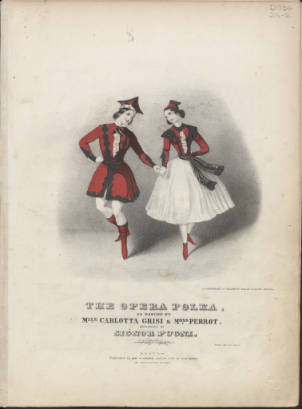Annotation:Opera Polka
X:1 T:Opera Polka M:2/4 L:1/8 R:Polka B:Manson - Hamilton's Universal Tune-Book (1846, p. 145) Z:AK/Fiddler's Companion K:D A|Ad {e}d/c/d|eA {B}A/^G/A|eAgA|ba a/g/f| Ad {e}d/c/d|eA {B}A/^G/A|eAgA|f/A/f/e/ d|| e/d/|c{^d}e {^g}ac'|c'b/a/ ^gf|fe {f}e/^d/e|fe {f}e/^d/e| c{^d}e {^g}ac'|c'b/a/ ^gf|f/e/^d/e/ f/e/c'/b/|a/e/c'/b/ az|| c'A c'b|ba a/g/f|aA ag|gf f/e/d| c'A c'b|ba a/g/f|ec'/b/ a/g/B/c/|dfd!D.C.!||
OPERA POLKA. AKA and see "Baden Baden Polka." English, Scottish; Polka. England; Dorset, Yorkshire. D Major ('A' and 'C' parts) & A Major ('B' part) {Trim}: C Major ('A' and 'C' parts) & G Major ('B' part) {Callaghan, Kerr, Merryweather & Seattle}. Standard tuning (fiddle). "AABBCC(Trio)AABB.

The melody was entered into several mid-19th century English musicians' manuscript copybooks, including those of Lawrence Leadley (Yorkshire), the Hardy Family (Dorset), and Michael Turner (Sussex). "Original Polka (The)" and "Opera Polka" are on the page next to each other in Hamilton's Universal Tune Book and both are contained in the Hardy family manuscripts, suggesting the Hardys used that volume as their source.

